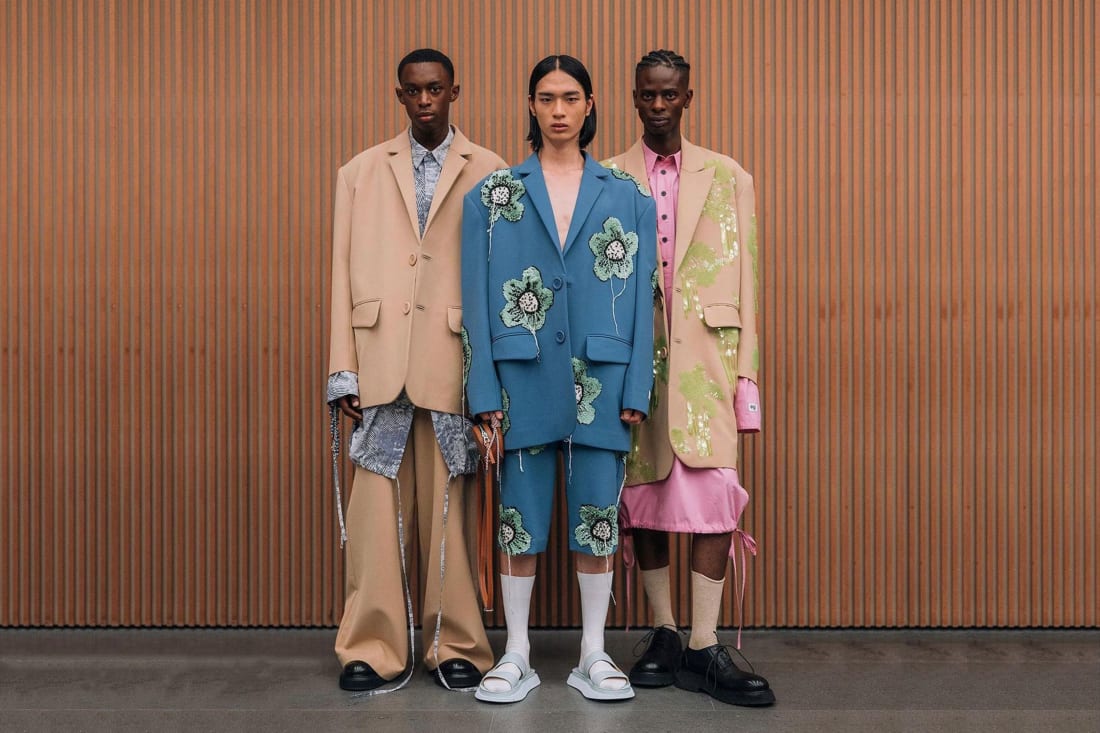How PFW Men's merged fashion, comedy, poetry and dance
This season, the designers bypassed traditional runway shows in favour of exciting, multidisciplinary performance
This season, the designers bypassed traditional runway shows in favour of exciting, multidisciplinary performance
What if a fashion show wasn’t just a fashion show? This is the question designers dared to answer this season at Men’s Fashion Week in Paris. Instead of models pacing up and down in a nondescript white space, they danced, told jokes and read poetry.
Fashion purists might claim that fashion week is and should be all about the clothes, but the truth is that it hasn’t been that way for a while, if it ever was. Fashion doesn’t exist in a vacuum. It feeds and responds to cultural trends in music, cinema, literature and theatre. Now, designers are crafting immersive experiences to reflect this symbiotic relationship.
This season, KidSuper’s Colm Dillane bypassed the traditional catwalk show in favour of a live comedy special hosted by Tyra Banks. Comedians Jeff Ross, Yvonne Orji, Stavros Halkias and more modelled the colourful art-infused streetwear collection with a microphone in hand and crude jokes spilling from their mouths. By using mostly comedians instead of the usual cast of runway models, Dillane also added some body diversity and relatability to the presentation.
Elsewhere, Rosalía revved up the energy for Dillane’s guest season at Louis Vuitton, performing atop a yellow car in the Louvre. The Spanish artist played four songs and curated the show’s playlist. The models themselves made their way through the colourful set, stopping to play chess and darts or to draw on the walls. There was so much going on that you could watch the livestream over and over yet still notice something new each time.
However, it wasn’t only KidSuper’s Dillane who pushed the fashion show in a more multidisciplinary direction. The Dior and Marine Serre shows were elevated to literary heights with moving poetic renditions. Kim Jones, who often taps 20th century literary movements for inspiration, had Robert Pattinson and Gwendoline Christie reciting T.S. Eliot’s 1922 poem The Wasteland as models walked past in fluid, neutral garments symbolising the text’s themes of renewal.
Meanwhile, Marine Serre used poetry to address contemporary concerns about the climate crisis. The show was set to a text the designer had written herself about the importance of reuse and repair. Models weaved past towering deadstock sculptures that further spoke to fashion’s waste problem.
Designers have always looked to wider culture for inspiration and merging fashion shows with performance isn’t new, but this season it felt less like a one-off way to build excitement and more like a new norm. Issey Miyake, for instance, has long pioneered the fashion show as a performance. The late Japanese designer always dreamed of becoming a dancer. Instead, he used fashion to emphasise the beauty of movement. Miyake retired in 1997 and passed away last year, but his vision lives on in the fashion house’s dynamic runway shows. This season, models at Issey Miyake Homme Plissé danced on the runway while a light show illuminated their moving bodies.
It’s easy to argue that the traditional runway show is a tired format. The cancellation of IRL fashion weeks during the pandemic forced designers to experiment with how they presented clothes, leading to the creation of interactive games or multidisciplinary short films. At the time, there was even talk of digital fashion weeks remaining the norm post-pandemic. Although in-person shows have inevitably returned, designers are applying the same creative thinking on the runway and proving that there’s still a place for real world shows, even if they look slightly different to before.
While last season had fun gimmicks like Gucci’s Twinsburg and Coperni’s spray-on dress, this fashion week was an ode to performance. Designers went beyond the clothes and contextualised them within the wider cultural landscape. Pretty much everyone gets dressed everyday so, essentially, anything and everything can be a fashion show.
Compared to other creative industries, fashion thrives on exclusivity. While tickets for gigs, theatre and comedy shows are available to the general public, fashion week is typically a closed off affair for selected influencers, press and buyers, shutting out an important demographic: the fans. Originally, fashion shows were intimate, functional interactions between couturiers and clients, but today they serve a different purpose. Fashion show performances create brand hype and entice viewers, whether they’re sitting in the audience or watching the livestream.
What’s more, brands are increasingly opening their guest lists up to the general public. Marine Serre’s AW23 show was open to the public on a first-come first-serve basis so students, fashion fans and the rest could experience it firsthand. Diesel and Raf Simons took a similar approach last season, suggesting that some fashion shows are becoming more like gigs or theatre performances where journalists, managers and fans are all mixed together.
This season’s performances prove that the IRL fashion show is well and truly back. But instead of stepping back in time to traditional runway presentations, designers brought a modern, engaging point of view that shook up what we’ve come to expect. There’s still drama and craft in the clothes themselves, but by opening up the fashion show format to include music, comedy and poetry, fashion shows are becoming more accessible, inclusive and in step with the times.



